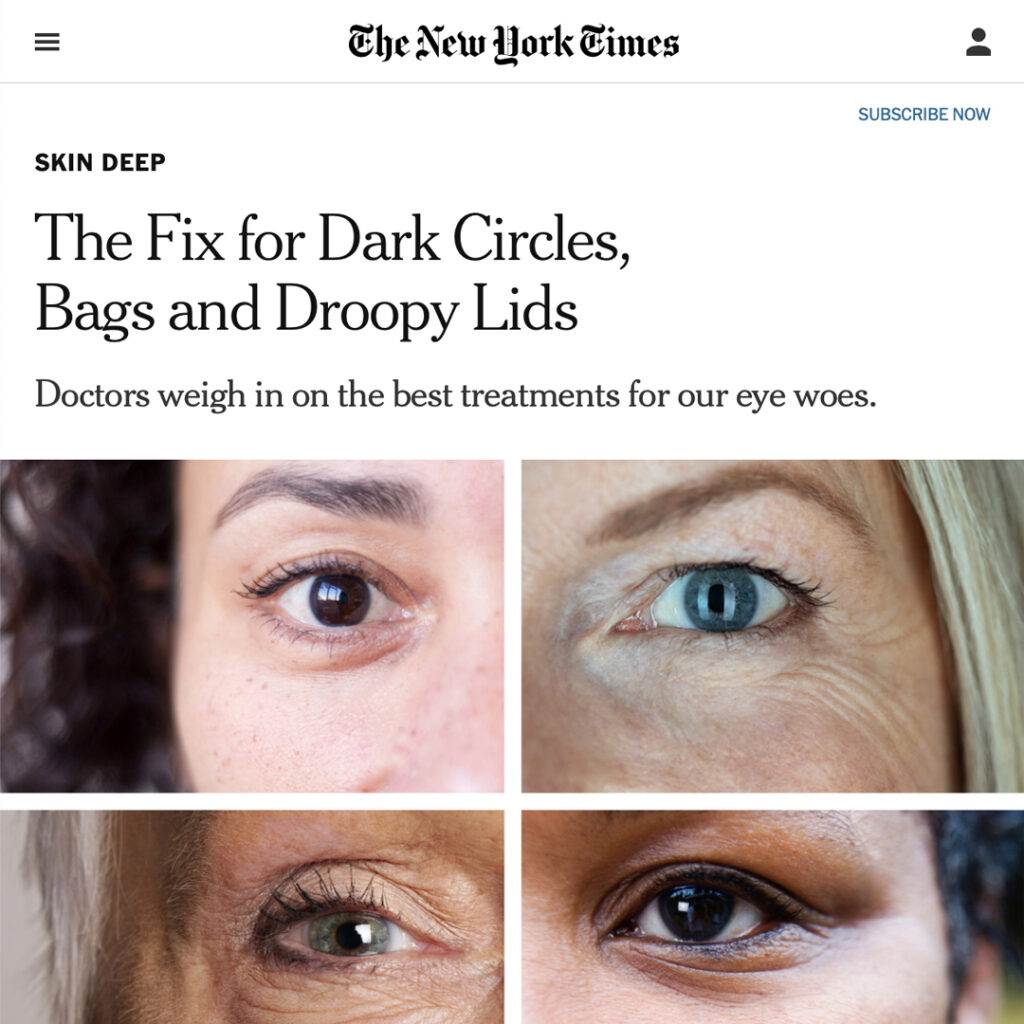The Fix for Dark Circles, Bags and Droopy Lids

Doctors weigh in on the best treatments for our eye woes.
The eyes have it — the good stuff (smiling, winking, widening in delight), and also the less-good stuff that goes with the good stuff (crow’s-feet, crinkling, under-eye bags). No one would advise you to give up the good. But is there a way to make the inevitable signs of a life fully lived a little less obvious?
Even those of us who are avid interventionists may shy away from eye procedures. The area is so delicate, its function so integral. As it turns out, though, noninvasive eye treatments use familiar tools of the anti-aging trade — neurotoxins (Botox and Dysport), fillers, lasers and collagen builders — often in interesting ways, to smooth, lift, plump and depuff.
Deflate Bags and Puffiness
First, eliminate the simple-fix causes of eye swelling, like seasonal allergies. “Some people have fluid retention, oftentimes due to allergies,” said Michelle Henry of the Laser & Skin Surgery Center of New York. “We can easily put them on an antihistamine.”
Otherwise, puffy eyes are the result of changes in underlying facial structures. As we age, muscles and other supportive tissues around the eye relax. That, paired with waning elasticity in the skin, causes fat that was once at deeper levels to migrate to the surface, causing eyelid bags.
“Further, as deep internal fat pads descend with age, the under-eye hollows, making the protrusion more pronounced,” Dr. Henry said.
Most people can be treated with fractional lasers, like the Fraxel Repair, to tighten the skin, along with filler for smoothing. “With bags you see the fullness and then a little depression, she said. “When you fill that depression, it creates an optical illusion of smoothness.”
Unless, of course, the bags are very big, in which case a blepharoplasty — surgery that removes excess skin and fat — will be necessary. Because puffiness is caused by changes in the underlying structures of the face, products, alas, can’t permanently correct them.
Smooth Wrinkles and Creases
“Botox works for crow’s-feet because it releases the muscle around the eye,” Dr. Henry said. “But as collagen wanes and the lines become etched in, the standard treatment is a fractional laser, which works particularly well when people have crepey skin around the eyes.
Fractional lasers make micro-injuries in the skin (and may leave you red for a couple of days). The resultant healing process creates collagen. For those with darker skin that is intolerant of fractional lasers, micro-needling will trigger collagen building.
As for eyelids (both top and bottom), they get crinkly and lose elasticity. Lasers and radio frequency treatments like Thermage will smooth and tighten that skin.
Lift Heavy Brows
A drooping brow could be a case of an over-Botoxed forehead. “The frontalis muscle in the forehead, whose job it is to raise the brow, is weakened when you over-inject it to smooth horizontal forehead lines,” said Marina Peredo of Skinfluence, a dermatology practice in Manhattan. “Then the brow drops.”
When a patient comes in complaining about forehead lines but also has a low brow, Dr. Peredo asks her to squint, frown and raise her brows, all in an attempt to see how the muscles are functioning.
“I tell them, ‘You can’t have both a smooth forehead and lifted brows,’” she said. “Ninety-nine percent of women prefer lines to heavy brows.”
Dr. Peredo also said that in the right hands, neurotoxins can do a lot to reshape brows: “We can elevate the center of the brow to get more arch, lift the tail of the brow to give it more of a flare, and lift the medial section of the brow to open up the eyes.”
Lighten Dark Circles
To treat dark circles, a doctor must first determine the cause. Volume loss, pigment and visible blood vessels, or some combination of all three, are the usual culprits. If you gently spread the area with your fingers so that the skin is tight, you’ll be able to see what’s going on.
“If the darkness disappears when you spread the skin, it’ll likely get better with filler,” Dr. Henry said. “What you’re seeing is shadows created by volume loss.” She injects hyaluronic acid fillers in the tear trough.
“My fillers of choice for this area are either Restylane Refyne for someone who needs a lot of volume, or Belotero, which we can inject more superficially on patients who don’t need a lot,” she said.
When you stretch your skin, you may also see blood vessels and brown pigment. “You’re seeing whatever is beneath the surface, and some of that is determined by genetics,” said Dhaval Bhanusali, a dermatologist who practices in New York and Miami. If the skin is very thin, you’ll see more of everything, so he suggests a gentle retinol, like RoC Retinol Correxion Eye Cream ($18), to thicken it.
Darkness caused by excess brown pigment (melanin) can be faded with topical products or in-office chemical peels. Kojic acid and vitamin C are on the gentler end of the spectrum, lightening pigment gradually. In-office peels fade melanin faster than over-the-counter products.
Lasers like the V Beam and Excel V target blood vessels, destroying them. The V Beam is better tolerated by people with light skin because the high energy used may cause hyperpigmentation in darker skin; the Excel V works well on all skin colors.
“Usually the vessels darken right after the treatment, then over two to three weeks, the body removes the debris and the pigment under the eyes dissipates,” Dr. Bhanusali said.
Volume loss in other parts of the face can cause under-eyes to look dark, too. Sunken temples, which create an unbalanced facial structure, can make the eyes look hollow. “A lot of things are involved — the forehead, cheeks, temples — so sometimes we have to treat those areas, too,” Dr. Peredo said. If a patient is concerned with shadowing around her eyes, she may inject filler to add volume at the temples.

FORT LEE, NJ
1640 Schlosser Street Suite C-3
Fort Lee, NJ 07024
CONTACT: 201-944-0808
contact@clearlaserskin.com


Manhattan, NY
501 5th Ave Suite 1601
New York, NY 10017
CONTACT: 212-697-1802
contact@clearlasercity.com


QUEENS, NY
210-16 Northern Blvd. #2A Bayside, NY 11361
CONTACT: 718-224-1720
contact@clearlaserqueens.com


JERSEY CITY, NJ
106 River Drive South Suite 2,
Jersey City, NJ 07310
CONTACT: 814-830-3581
contact@clearlaserjc.com


The information on this website, including articles authored by healthcare professionals, is for general information purposes only, does not constitute medical advice and is not intended to be relied upon for medical diagnosis or treatment. If you are experiencing an emergency, contact 911 or contact a medical provider immediately. Consistent with Clear Laser Skin Clinic website privacy policy, Clear Laser Skin Clinic is not responsible for the privacy practices or the content found at links to other websites.
- 2023 © Clear Laser Skin Clinic. All rights reserved | Powered by MOBIWEBI INC.

Leave a Reply